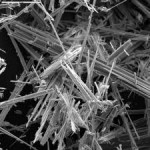 Polarized Light Microscopy (PLM) is the technique most often used for the analysis of building materials. Using light microscopy, this technique utilizes the unique features of polarized light to observe mineral specific optical properties. PLM can differentiate asbestos from non-asbestos fibers and classify the various asbestos mineral species . In addition, the identity of the non-asbestos components of each sample are recorded.
Polarized Light Microscopy (PLM) is the technique most often used for the analysis of building materials. Using light microscopy, this technique utilizes the unique features of polarized light to observe mineral specific optical properties. PLM can differentiate asbestos from non-asbestos fibers and classify the various asbestos mineral species . In addition, the identity of the non-asbestos components of each sample are recorded.
Bulk Asbestos Samples – Micron uses polarized light microscopy (PLM) to identify and quantify the percentages of asbestos in bulk materials from <1 percent to 100 percent. Micron follows the EPA Interim Method for the Determination of Asbestos in Bulk Insulation Samples as found in 40 CFR 763.109 Appendix E to Subpart E and EPA Method EPA/600/R-93/116, Method for the Determination of Asbestos in Bulk Building Materials. The PLM technique may be performed either by visual estimation or by point counting. Point Counting provides a determination of the area percentage of asbestos in a sample. Micron uses the semi-quantitative point count method using gravimetry/mass reduction to quantify samples with low asbestos concentration. The 400 point count complies with NESHAP regulations which require that point counting be performed for better precision and accuracy on samples with low concentrations of asbestos. The 1000 point count is used primarily in the state of California where a stricter ACM (Asbestos Containing Material) definition of 0.1% is used.
Airborne Fiber Samples – Micron uses the NIOSH 7400 Method (“A” Rules) to measure the concentration of airborne fibers in collection filters using Phase Contrast Microscopy (PCM).
Request for Laboratory Services
